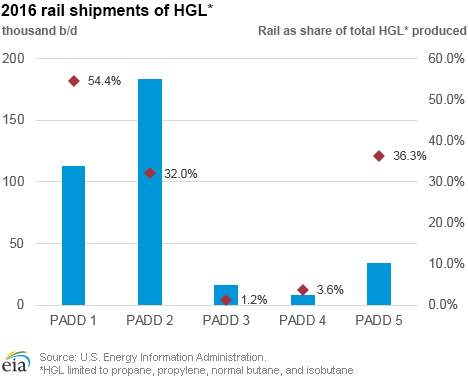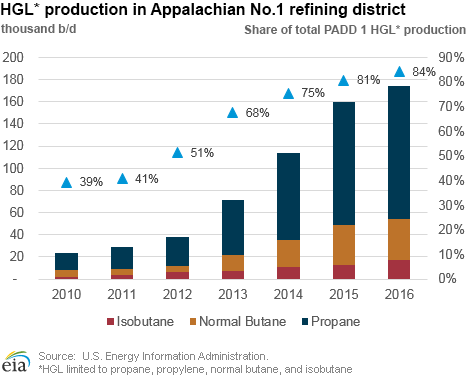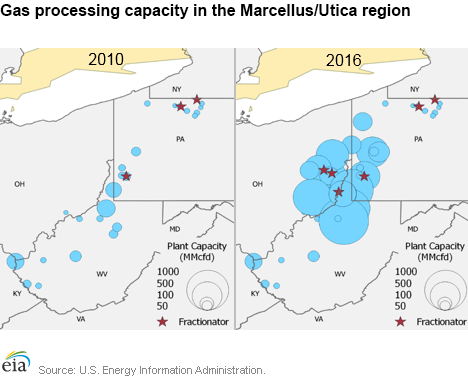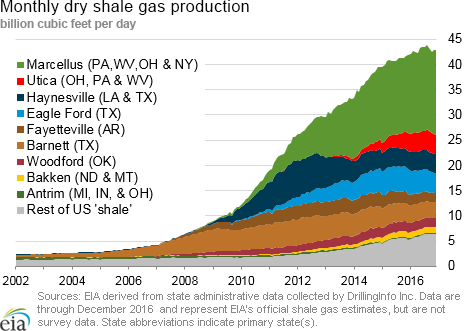In the News:
Rail provides outlet for growing Appalachian HGL production
The East Coast region is most dependent on rail to transport hydrocarbon gas liquids (HGL), according to a new EIA data series published in Movements of Crude Oil and Selected Products by Rail. EIA’s HGL-by-rail data include shipments of propane, propylene, normal butane, and isobutane between and within Petroleum Administration for Defense District (PADD) regions and to and from Canada. In the East Coast region (PADD 1), more than half of the production of these fuels is moved by rail. The additional inter- and intra-PADD rail movements of HGL, along with increased natural gas processing capacity, support increased natural gas production there.
Between 2010 and 2016 through November, natural gas marketed production in PADD 1 grew from a little less than 3 billion cubic feet per day (Bcf/d) to more than 18 Bcf/d, with Pennsylvania and West Virginia accounting for all growth. The midstream industry significantly expanded natural gas processing capacity in the region during this time period to accommodate the rapid growth, but the capacity to move the extracted HGL within and out of PADD 1 via pipeline was constrained. Rail, therefore, became an important option for producers who needed to move their rising output of HGL to market, particularly in the summer months when in-region demand is low and storage capacity is scarce. Production of the four HGL that move on rail in the Appalachian No. 1 refining district, which includes counties in western Pennsylvania and all West Virginia, grew from 24,000 barrels per day (b/d) in 2010 to 174,000 b/d in the first 11 months of 2016. These counties’ share of production grew from under 40% to nearly 85% of PADD 1 output.
In regions such as the Gulf Coast (PADD 3) where the Barnett, Permian, and Eagle Ford shale formations are located, more extensive pipeline systems were able to accommodate transport of the growing HGL supply. Adequate pipeline capacity is lacking in the Northeast, and midstream companies continue to expand the HGL pipeline network there so that in time, capacity to ship HGL by pipe from the Appalachian region may increase. The nature of the East Coast market and the anticipated growth in natural gas and HGL production in the region suggest that rail will continue to have a role in intra- and inter-PADD 1 HGL transport.
Overview:
(For the Week Ending Wednesday, February 8, 2017)
- Natural gas spot prices fell at most locations this report week (Wednesday, February 1 to Wednesday, February 8). The Henry Hub spot price fell from $3.12 per million British thermal units (MMBtu) last Wednesday to $3.05/MMBtu yesterday.
- At the New York Mercantile Exchange (Nymex), the March 2017 contract price fell 4¢ from $3.168/MMBtu last Wednesday to $3.126/MMBtu yesterday.
- Net withdrawals from working gas totaled 152 Bcf for the week ending February 3. Working natural gas stocks are 2,559 Bcf, which is 11% less than the year-ago level and 2% more than the five-year (2012–16) average for this week.
- The natural gas plant liquids composite price at Mont Belvieu, Texas, rose by $1.02, closing at $7.69/MMBtu for the week ending February 3. This increase was driven by a 26% increase in ethane prices. The price of natural gasoline, propane, butane, and isobutane also rose by 16%, 12%, 15%, and 13%, respectively.
- According to Baker Hughes, for the week ending Friday, February 3, the natural gas rig count remained flat at 145. The number of oil-directed rigs rose by 17 to 583. The total rig count climbed by 17, and it now stands at 729.
Prices/Supply/Demand:
Prices fall outside the Northeast. This report week (Wednesday, February 1 to Wednesday, February 8), the Henry Hub spot price fell 7¢ from $3.12/MMBtu last Wednesday to $3.05/MMBtu yesterday after hitting a low of $2.92/MMBtu on Monday. Spot prices at the Chicago Citygate decreased 6¢ from $3.08/MMBtu last Wednesday to $3.02/MMBtu yesterday. Prices at PG&E Citygate in Northern California lost 11¢, down from $3.50/MMBtu last Wednesday to $3.39/MMBtu yesterday. The price at SoCal Citygate decreased 25¢ from $3.31/MMBtu last Wednesday to $3.06/MMBtu yesterday.
Northeast braces for snow. At the Algonquin Citygate, which serves Boston-area consumers, prices went up 12¢ from $5.39/MMBtu last Wednesday to $5.51/MMBtu yesterday. Although prices at Algonquin fell as low as $3.06/MMBtu on Monday when weather forecasts turned warm, prices spiked yesterday as the Northeast prepared for a winter storm. Transcontinental Pipeline Zone 6 trading point for New York increased $1.10 from $3.40/MMBtu last Wednesday to $4.50/MMBtu yesterday. This point saw similar weather-related trends: prices hit a low of $2.64/MMBtu on Monday and then rose sharply yesterday.
Tennessee Zone 4 Marcellus spot prices decreased 14¢ from $2.75/MMBtu last Wednesday to $2.61/MMBtu yesterday. Prices at Dominion South in northwest Pennsylvania fell 10¢ from $2.90/MMBtu last Wednesday to $2.80/MMBtu yesterday. Prices at both of these points rose slightly from mid-week lows, but did not see price swings on the same scale as those in Boston and New York City.
March Nymex contract down slightly. At the Nymex, the price of the March 2017 contract decreased 4¢, from $3.168/MMBtu last Wednesday to $3.126/MMBtu yesterday. The price of the 12-month strip, averaging March 2017 through February 2018, futures contracts moved in the opposite direction, climbing 2¢ to $3.384/MMBtu.
Supply remains flat. According to data from PointLogic, the average total supply of natural gas remained the same as the previous report week, averaging 76.2 Bcf/d, which is 4% below last year at this time. Dry natural gas production remained constant week over week, while average net imports from Canada decreased by 2%.
Demand falls as weather warms. Total U.S. consumption of natural gas fell by 5% compared with the previous report week, according to data from PointLogic. Power burn declined by 2% week over week, while industrial sector consumption decreased by 1% week over week. The largest decrease was in the residential and commercial sectors, where consumption declined by 8%—more than 3 Bcf/d—as temperatures rose around the country. Natural gas exports to Mexico decreased 1%.
U.S. liquefied natural gas (LNG) exports. Natural gas pipeline deliveries to the Sabine Pass liquefaction terminal averaged 2.1 Bcf/d for the report week, 20% higher than in the previous week. Three vessels (combined LNG-carrying capacity of 10.8 Bcf) departed Sabine Pass last week.
Storage:
Colder temperatures during the week contribute to larger than average net withdrawals. Net withdrawals from storage totaled 152 Bcf, compared with the five-year (2012–16) average net withdrawal of 138 Bcf and last year's net withdrawals of 93 Bcf during the same week. Colder temperatures throughout the week for most of the Lower 48 states contributed to increased heating demand for natural gas and withdrawals from storage. Working gas stocks totaled 2,559 Bcf, which is 325 Bcf less than last year at this time and 45 Bcf more than the five-year average.
Working gas stocks remain above the five-year average. Although Lower 48 working gas stocks exceeded the five-year average in total, stocks in several regions remain below their five-year averages. The East, Pacific, and South Central Nonsalt regions are 47, 45, and 23 Bcf below their five-year averages, respectively. The Midwest, Mountain, and South Central salt regions are 48 Bcf, 8 Bcf, and 106 Bcf above their five-year averages, respectively.
Working gas reclassified to base gas. EIA reported 5Bcf of working gas reclassifications to base gas storage. A reclassification is a change to working gas levels where gas was not injected or withdrawn from a facility. The working gas levels can increase if the reclassification is from base gas to working gas and can decrease if the reclassification goes in the opposite direction. A reclassification can be the result of an inventory adjustment after an engineering study. Reclassifications in the Weekly Natural Gas Storage Report (WNGSR) report affect only changes in the current week. The net change in reported stock levels of working gas in storage includes injections, withdrawals, and reclassifications between base and working gas. Excluding the effect of the reclassification, implied flows from storage totaled 147 Bcf as compared to the 152 Bcf net withdrawals, which include the reclassified volumes.
Net withdrawals fall within range of market expectations. According to the Bloomberg survey of natural gas analysts, estimates of net natural gas withdrawals from storage generally ranged from 149 Bcf to 160 Bcf, with a median of 155 Bcf. The price of the Nymex futures contract for March 2017 delivery at Henry Hub fell 2¢/MMBtu to $3.15 MMBtu in 396 trades at the release of the WNGSR.
Temperatures fall on the week, but remain higher than normal. Temperatures in the Lower 48 states averaged 38°F, 4°F higher than normal and 4°F lower than last year at this time. Temperatures fell 6°F on average for the week in the Lower 48 states. Temperatures in most regions outside of the Mountain region were significantly higher than seasonal norms for the period. Heating degree days (HDD) in the Lower 48 states totaled 191, compared with 166 last year and a normal of 219.
See also:
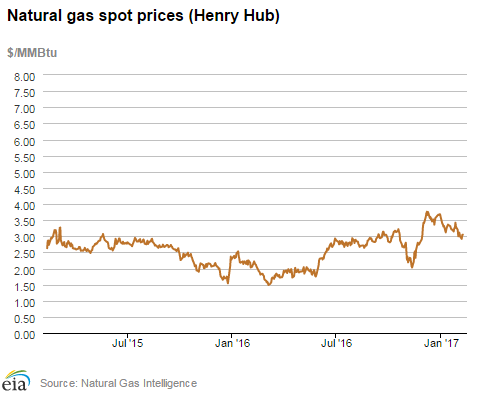
| Spot Prices ($/MMBtu) | Thu, 02-Feb |
Fri, 03-Feb |
Mon, 06-Feb |
Tue, 07-Feb |
Wed, 08-Feb |
|---|---|---|---|---|---|
| Henry Hub |
3.10 |
3.00 |
2.92 |
3.04 |
3.05 |
| New York |
3.66 |
3.26 |
2.64 |
2.83 |
4.50 |
| Chicago |
3.06 |
2.94 |
2.88 |
3.02 |
3.02 |
| Cal. Comp. Avg.* |
3.08 |
3.00 |
2.95 |
3.09 |
3.02 |
| Futures ($/MMBtu) | |||||
| March contract | 3.126 |
3.130 |
3.050 |
3.063 |
3.187 |
| April Contract |
3.360 |
3.211 |
3.257 |
3.295 |
3.346 |
| *Avg. of NGI's reported prices for: Malin, PG&E Citygate, and Southern California Border Avg. | |||||
| Source: NGI's Daily Gas Price Index | |||||
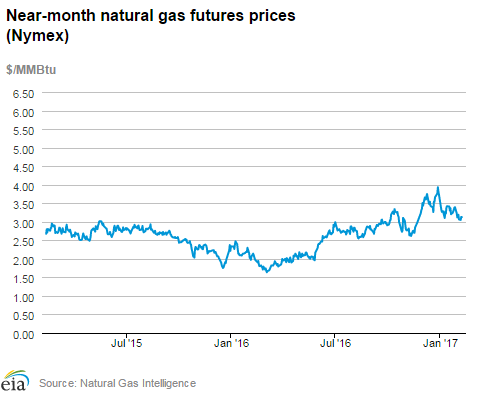
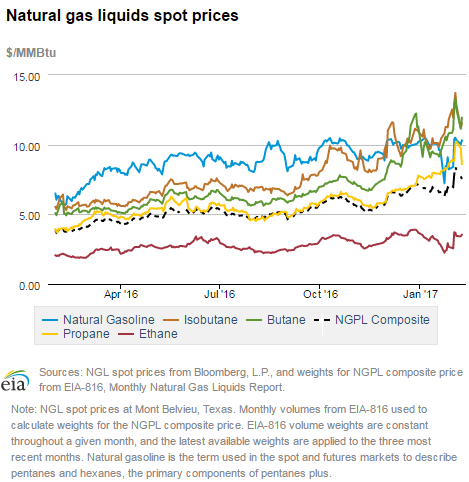
| U.S. natural gas supply - Gas Week: (2/2/17 - 2/8/17) | |||
|---|---|---|---|
Average daily values (Bcf/d): |
|||
this week |
last week |
last year |
|
| Marketed production | 78.8 |
78.9 |
82.1 |
| Dry production | 70.3 |
70.4 |
73.6 |
| Net Canada imports | 5.9 |
6.0 |
5.8 |
| LNG pipeline deliveries | 0.1 |
0.2 |
0.3 |
| Total supply | 76.2 |
76.5 |
79.7 |
|
Source: OPIS PointLogic Energy, an IHS Company | |||
| U.S. natural gas consumption - Gas Week: (2/2/17 - 2/8/17) | |||
|---|---|---|---|
Average daily values (Bcf/d): |
|||
this week |
last week |
last year |
|
| U.S. consumption | 80.2 |
84.2 |
87.6 |
| Power | 21.3 |
21.7 |
24.8 |
| Industrial | 22.5 |
22.7 |
22.7 |
| Residential/commercial | 36.4 |
39.8 |
40.0 |
| Mexico exports | 4.0 |
4.0 |
3.4 |
| Pipeline fuel use/losses | 6.3 |
6.6 |
6.9 |
| LNG pipeline receipts | 2.1 |
1.8 |
0.0 |
| Total demand | 92.6 |
96.6 |
97.8 |
|
Source: OPIS PointLogic Energy, an IHS Company | |||
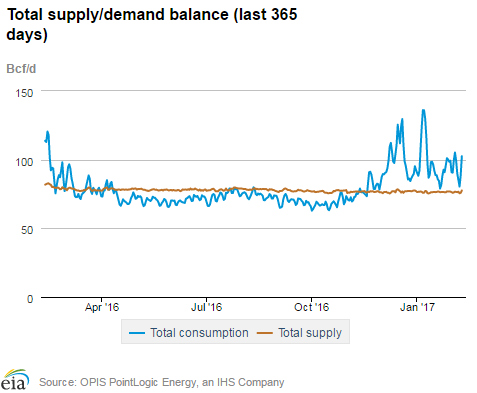
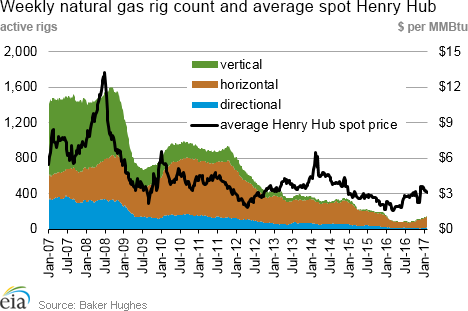
| Rigs | |||
|---|---|---|---|
Fri, February 03, 2017 |
Change from |
||
last week |
last year |
||
| Oil rigs | 583 |
3.0% |
24.8% |
| Natural gas rigs | 145 |
0.0% |
39.4% |
| Miscellaneous | 1 |
0.0% |
0.0% |
| Rig numbers by type | |||
|---|---|---|---|
Fri, February 03, 2017 |
Change from |
||
last week |
last year |
||
| Vertical | 67 |
-6.9% |
11.7% |
| Horizontal | 596 |
2.9% |
30.1% |
| Directional | 66 |
8.2% |
24.5% |
| Source: Baker Hughes Inc. | |||
| Working gas in underground storage | ||||
|---|---|---|---|---|
Stocks billion cubic feet (Bcf) |
||||
| Region | 2017-02-03 |
2017-01-27 |
change |
|
| East | 520 |
569 |
-49 |
|
| Midwest | 685 |
730 |
-45 |
|
| Mountain | 155 |
164 |
-9 |
|
| Pacific | 208 |
221 |
-13 |
|
| South Central | 991 |
1,027 |
-36 |
|
| Total | 2,559 |
2,711 |
-152 |
|
| Source: U.S. Energy Information Administration | ||||
| Working gas in underground storage | |||||
|---|---|---|---|---|---|
Historical comparisons |
|||||
Year ago (2/3/16) |
5-year average (2012-2016) |
||||
| Region | Stocks (Bcf) |
% change |
Stocks (Bcf) |
% change |
|
| East | 626 |
-16.9 |
567 |
-8.3 |
|
| Midwest | 747 |
-8.3 |
637 |
7.5 |
|
| Mountain | 153 |
1.3 |
147 |
5.4 |
|
| Pacific | 262 |
-20.6 |
253 |
-17.8 |
|
| South Central | 1,096 |
-9.6 |
909 |
9.0 |
|
| Total | 2,884 |
-11.3 |
2,514 |
1.8 |
|
| Source: U.S. Energy Information Administration | |||||
| Temperature – heating & cooling degree days (week ending Feb 02) | ||||||||
|---|---|---|---|---|---|---|---|---|
HDD deviation from: |
CDD deviation from: |
|||||||
| Region | HDD Current |
normal |
last year |
CDD Current |
normal |
last year |
||
| New England | 235 |
-39 |
44 |
0 |
0 |
0 |
||
| Middle Atlantic | 224 |
-37 |
20 |
0 |
0 |
0 |
||
| E N Central | 260 |
-31 |
52 |
0 |
0 |
0 |
||
| W N Central | 248 |
-57 |
37 |
0 |
0 |
0 |
||
| South Atlantic | 152 |
-26 |
13 |
2 |
-5 |
-4 |
||
| E S Central | 153 |
-28 |
35 |
0 |
-1 |
-1 |
||
| W S Central | 95 |
-35 |
19 |
2 |
-2 |
-4 |
||
| Mountain | 221 |
-1 |
15 |
0 |
-1 |
0 |
||
| Pacific | 105 |
-8 |
-6 |
0 |
-1 |
0 |
||
| United States | 191 |
-28 |
25 |
1 |
-1 |
-1 |
||
|
Note: HDD = heating degree day; CDD = cooling degree day Source: National Oceanic and Atmospheric Administration | ||||||||
Average temperature (°F)
7-Day Mean ending Feb 09, 2017
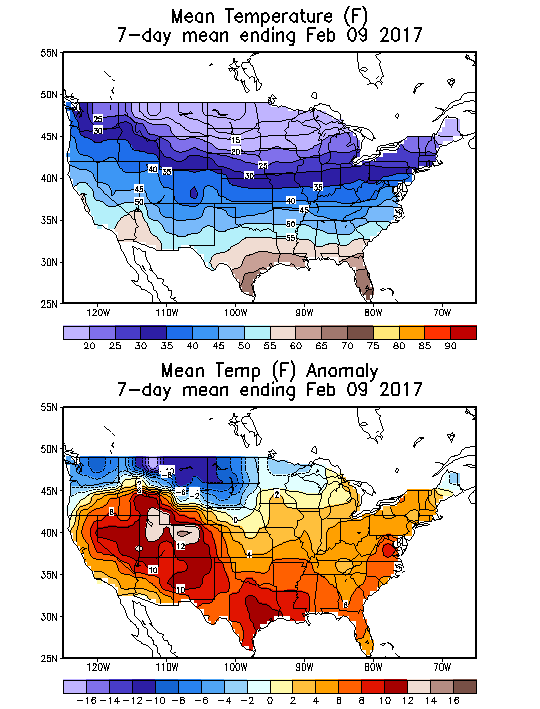
Source: NOAA National Weather Service
Deviation between average and normal (°F)
7-Day Mean ending Feb 09, 2017

Source: NOAA National Weather Service

